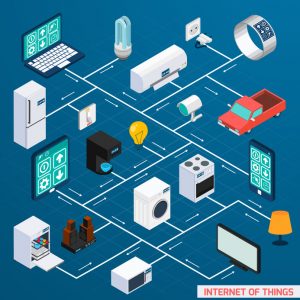Have you tried to buy a refrigerator lately?

When someone at a local appliance store told me that the new Samsung refrigerator can connect to the Internet and show me all the recipes for Lasagna and recommend the best ingredients and even choose the right temperature for storing the leftovers…Really!
It’s a far cry from the old days. Maybe it’s time to learn about the Internet of Things (IoT).
“What on earth is that?”
The IoT is made up of an increasing number of connected and network enabled devices that we use at home, at work, and everywhere in between. We all know about our smart phones and tablets and computers, but you may be surprised to learn just how extensive the list of connected devices is. Some thermostats are now part of the IoT, collecting data and allowing you to remotely control your home’s heating and cooling. There are applications that allow you to control your home’s lights and door locks via your phone. Many people now wear fitness trackers – usually as a wristband – that collect and wirelessly communicate health and exercise data to your other devices.
But it has – and will – go much further than that. There are already connected toothbrushes and clothing. Refrigerators and washing machines. Televisions and gaming consoles. Even cars.
“Is this a good thing?”
Answers to this question will certainly run the gamut depending on who you ask. There’s no denying that the IoT brings efficiency and convenience to our everyday activities. For example, when your car’s GPS automatically communicates with traffic sensors and reroutes your trip, it’s saving you time and money. When your thermostat senses when you arrive home and automatically increases the temperature (or automatically lowers it when it senses you leaving) it provides energy efficiency. When your fitness band automatically records your steps and how many calories you’ve burned today, it can communicate that to a dieting app on your smartphone and better inform your exercise decisions later in the day.
However….
Aside from the whole, “computers taking over the world” fear, there are some very practical security concerns that come with the IoT. Every connection to your network is a potential gateway for hackers and other evil doers. This has always been true, but unlike a laptop or phone, the company producing a smart hairdryer or a smart car doesn’t necessarily put security at the top of their priority list. Nor do they always have the experience and knowledge to do a good job with security even when they do think about it.
In addition, there are more direct risks associated with the IoT. For example, you can easily imagine the dangers posed by a baby-monitor webcam that’s hacked. Or the audio sensors on a smart TV. Or the security system controlling the locks to your house.
“So should I unplug everything and move to a cabin in the woods?”
While caution is certainly called for, we don’t need to panic. The IoT is here to stay, but there are things you can do to limit your risk.
- Decide how connected you want to be. The more IoT devices you have, the more risk there is that one of them will be compromised. So if that smart coffee maker isn’t really that important to you, maybe you can just settle for a traditional “dumb” one. Also, there’s no need for every smart device to also be connected to the internet.
- Make sure your home network is secure. Much of the IoT will be running on your home network (likely wireless), so if you can control that, you’ve taken a big step towards securing your individual devices. We’ve written a detailed article on how to do this here.
- Like we’ve said before, make sure all the passwords you use – even on your smart TV or toaster oven – are strong and unique, and never use the default password that comes with a product.
- Make sure your devices are updated regularly as some manufacturers will release bug fixes and security updates to their products.
For more information on securing the IoT in your own home, you can check out these articles:
- 7 Tips for Securing the Internet of Things
- How to Secure Your Internet of Things
- 5 Simple Steps to Protect Yourself from IoT Security Threats
